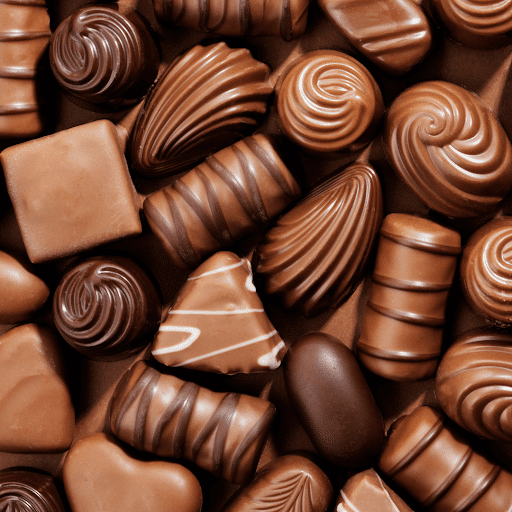Guys, it’s time to talk about one of my faaaavorite subjects: chocolate!
As a self-proclaimed chocoholic with a love for snacking, I’m excited to chat all about chocolate today.
In this blog post, I’m going over the history, types, pairings, and uses of this delightful treat.
And so much more!
Whether you’re a fan of creamy milk chocolate, intense dark chocolate, or the unique and lesser-known, ruby chocolate, there’s something here for everyone. Let’s dive in!
The History of Chocolate
Chocolate’s rich history begins with the ancient civilizations of Mesoamerica. Check out these fun facts. Perhaps they’ll be useful in trivia one day! 😉
- Origins: The cacao tree (Theobroma cacao) was first cultivated by the Olmecs, Mayans, and Aztecs.
- Ancient Uses: Cacao beans were used as currency and made into a bitter beverage known as “xocoatl.”
- Introduction to Europe: Spanish explorers brought chocolate to Europe in the 16th century, where it quickly became a favorite among the aristocracy.
How Chocolate is Made
Making chocolate is an art that involves several key steps:
- Harvesting Cacao Beans: Cacao pods are harvested from cacao trees, primarily found in regions like the Ivory Coast.
- Fermentation: Beans are fermented to develop their flavor.
- Drying: Fermented beans are dried under the sun.
- Roasting: Beans are roasted to bring out their rich flavor.
- Grinding: Ground cocoa beans become cocoa mass or pure chocolate liquor.
- Conching: The chocolate is refined to achieve a smooth texture.
- Tempering: This process ensures the chocolate has a shiny finish and snaps when broken.
Types of Chocolate
Chocolate comes in various types, each with unique characteristics:
- Dark Chocolate: Made with higher cocoa content and less sugar, offering an intense flavor.
- Milk Chocolate: Contains milk solids and milk fat, giving it a creamy texture.
- White Chocolate: Made from cocoa butter, sugar, and milk solids, with no cocoa mass.
- Ruby Chocolate: Made from ruby cocoa beans, known for its pink color and fruity taste.
- Bittersweet and Semisweet Chocolate: Used in baking, these have varying amounts of sugar and cocoa.
- Unsweetened Chocolate: Pure chocolate liquor with no added sugar, used primarily in baking.
Chocolate pairs beautifully with a variety of foods and drinks. Here are some specific pairings for different types of chocolate:
- Dark Chocolate:
- Fruits: Raspberries, blackberries, and cherries
- Nuts: Walnuts, pistachios, and almonds
- Cheeses: Aged cheddar, blue cheese, and Roquefort
- Beverages: Cabernet Sauvignon, espresso, and stout beer
- Milk Chocolate:
- Fruits: Strawberries, bananas, and apples
- Nuts: Hazelnuts, almonds, and peanuts
- Cheeses: Brie, Gouda, and mild cheddar
- Beverages: Merlot, latte, and light beer
- White Chocolate:
- Fruits: Mango, peaches, and raspberries
- Nuts: Macadamia nuts, cashews, and almonds
- Cheeses: Ricotta, mascarpone, and mild feta
- Beverages: Champagne, chai tea, and sweet dessert wine
- Ruby Chocolate:
- Fruits: Berries (strawberries, raspberries, blackberries)
- Nuts: Pistachios, almonds, and pecans
- Cheeses: Goat cheese, fresh mozzarella, and cream cheese
- Beverages: Rosé wine, fruity cocktails, and sparkling water
- Bittersweet Chocolate:
- Fruits: Figs, apricots, and dates
- Nuts: Pecans, almonds, and hazelnuts
- Cheeses: Sharp cheddar, Parmesan, and Gruyère
- Beverages: Zinfandel, dark roast coffee, and port wine
- Semisweet Chocolate:
- Fruits: Pears, cherries, and oranges
- Nuts: Walnuts, almonds, and cashews
- Cheeses: Gouda, Havarti, and blue cheese
- Beverages: Pinot Noir, black tea, and amber ale
Chocolate in Baking
Different types of chocolate are best suited for various baking needs:
- Bittersweet and Semisweet Chocolate: Ideal for cookies, brownies, and cakes.
- Milk Chocolate: Perfect for ganache and frosting.
- White Chocolate: Great for blondies and white chocolate mousse.
- Dark Chocolate: Excellent for rich desserts like flourless chocolate cake.
- Couverture Chocolate: Used by pastry chefs for its high cocoa butter content, perfect for tempering and enrobing.

Tips About Chocolate
Here are some handy tips for enjoying and working with chocolate:
- Storage: Keep chocolate at room temperature in a cool, dry place.
- Melting: Use a double boiler or microwave in short bursts to avoid burning.
- Pairing: Match the intensity of the chocolate with the flavor profile of the pairing ingredient.
- Quality: Choose good chocolate with high cocoa content and minimal vegetable fats for the best flavor.
Fun Facts About Chocolate
- Health Benefits: Dark chocolate is rich in antioxidants and can improve heart health.
- Ruby Chocolate: The newest type of chocolate, introduced by Barry Callebaut, is naturally pink and has a unique, tangy flavor.
- Oldest Chocolate Bar: The first chocolate bar was created in the 19th century by Joseph Fry.
- Cocoa Nibs: These are small pieces of crushed cacao beans with a crunchy texture and intense chocolate flavor.
Books About Chocolate
I love reading and when I want to learn about something in-depth, I typically reach for a book. Here are a few great reads that will help you expand your chocolate knowledge.
- “The True History of Chocolate” by Sophie D. Coe and Michael D. Coe
- A comprehensive look at chocolate’s journey from ancient Mesoamerica to the modern world.
- “Chocolate: A Bittersweet Saga of Dark and Light” by Mort Rosenblum
- A fascinating exploration of chocolate’s impact on culture and economy.
- “The Art of Chocolate Making” by Anne Scott
- A guide for aspiring chocolatiers with recipes and techniques.
- “The Chocolate Bible” by Le Cordon Bleu
- A collection of delicious recipes from the famed culinary school.
- “Chocolate Wars: The 150-Year Rivalry Between the World’s Greatest Chocolate Makers” by Deborah Cadbury
- A historical account of the competition among the world’s leading chocolate brands.
Chocolate Varieties and Their Unique Characteristics
Different kinds of chocolate have distinct flavor profiles and textures:
- Bittersweet Chocolate: Less sugar, higher cocoa content, intense flavor.
- Semisweet Chocolate: Balanced sweetness, versatile for baking.
- Milk Chocolate: Smooth milk chocolate with a creamy texture and sweet flavor.
- White Chocolate: Sweet, rich, and creamy with no cocoa solids.
- Ruby Chocolate: Fruity and tangy with a distinctive pink color.
- Dark Chocolate: Strong chocolate flavor with higher cocoa content.
- Blonde Chocolate: Caramelized white chocolate with a toasty, sweet flavor.

Chocolate and Health
While chocolate is a delightful treat, it also offers some health benefits:
- Antioxidants: Dark chocolate is rich in flavonoids, which can help reduce inflammation.
- Heart Health: Moderate consumption of dark chocolate can improve heart health.
- Mood Booster: Chocolate stimulates the release of endorphins, making you feel happier.
Chocolate Making Process
Did you know that you can make chocolate at home? I insist you try! Making chocolate at home can be a really fun experience. Here’s a simple overview:
- Ingredients: Gather high-quality cocoa beans, sugar, and milk powder.
- Roasting: Roast the beans at a low temperature to develop flavor.
- Grinding: Grind the beans into a fine powder.
- Mixing: Combine the ground beans with sugar and milk powder.
- Conching: Refine the mixture to achieve a smooth texture.
- Tempering: Heat and cool the chocolate to stabilize it.
- Molding: Pour the tempered chocolate into molds and let it set.
Types of Chocolates for Different Baking Needs
Different types of chocolate are suited for various baking recipes:
- Unsweetened Chocolate: Best for baking when you want to control the amount of sugar in the recipe.
- Bittersweet and Semisweet Chocolate: Perfect for cookies and brownies.
- Milk Chocolate: Great for ganaches and creamy desserts.
- White Chocolate: Ideal for decorating and making truffles.
- Couverture Chocolate: Used by professionals for its high cocoa butter content and smooth texture.
Popular Chocolate Brands
I love a good, high-quality chocolate bar. Here are some popular brands I’ve tried and loved:
- Barry Callebaut: Known for their innovative ruby chocolate.
- Valrhona: Famous for their high-quality baking chocolates.
- Ghirardelli: A popular choice for both baking and snacking.
- Lindt: Known for their smooth and creamy chocolates.
- Hershey’s: A household name in the United States, offering a wide range of chocolate products.
- Green & Black’s: Offers organic and fair-trade chocolates with rich flavors and high cocoa content.
- Tony’s Chocolonely: Known for their commitment to fair trade and creating slave-free chocolate, with unique and delicious flavor combinations.
Chocolate Trends
As someone who works in food marketing, I have to keep an eye out on food trends. Here are some that I often see, both online, and at retailers.
- Bean-to-Bar: Artisanal chocolates made from scratch by small producers.
- Single-Origin Chocolate: Chocolates made from beans sourced from a single region, highlighting unique flavor profiles.
- Chocolate and Spice: The combination of chocolate with spices like chili and cinnamon for a unique flavor experience.
- Vegan Chocolate: Dairy-free chocolates made with alternative ingredients like coconut milk.

The Best Way to Enjoy Chocolate
Everyone has their own favorite way to enjoy chocolate. Mine is either in a chocolate chip cookie or just as a few pieces of a bar. Here are a few more ideas:
- Snacking: Enjoy a bar of chocolate on its own for a quick treat.
- Baking: Incorporate chocolate into your favorite recipes, from cookies to cakes.
- Pairing: Pair chocolate with wine, cheese, or coffee for a sophisticated experience.
- Melting: Use melted chocolate to dip fruits, marshmallows, or pretzels.
Chocolate for Special Occasions
Chocolate is perfect for celebrating special moments:
- Valentine’s Day: Gift a box of chocolates to your loved one.
- Easter: Enjoy chocolate eggs and bunnies.
- Christmas: Share chocolate treats with family and friends.
- Birthdays: Bake a chocolate cake or make homemade truffles.
Chocolate is more than just a sweet treat; it’s a versatile ingredient with a rich history and a variety of uses in the culinary world. From the smooth texture of milk chocolate to the intense flavor of dark chocolate, there’s a type for every taste bud.
Whether you’re snacking on a bar of chocolate, baking a decadent dessert, or pairing it with your favorite wine, chocolate never fails to bring joy and satisfaction. Happy snacking!










